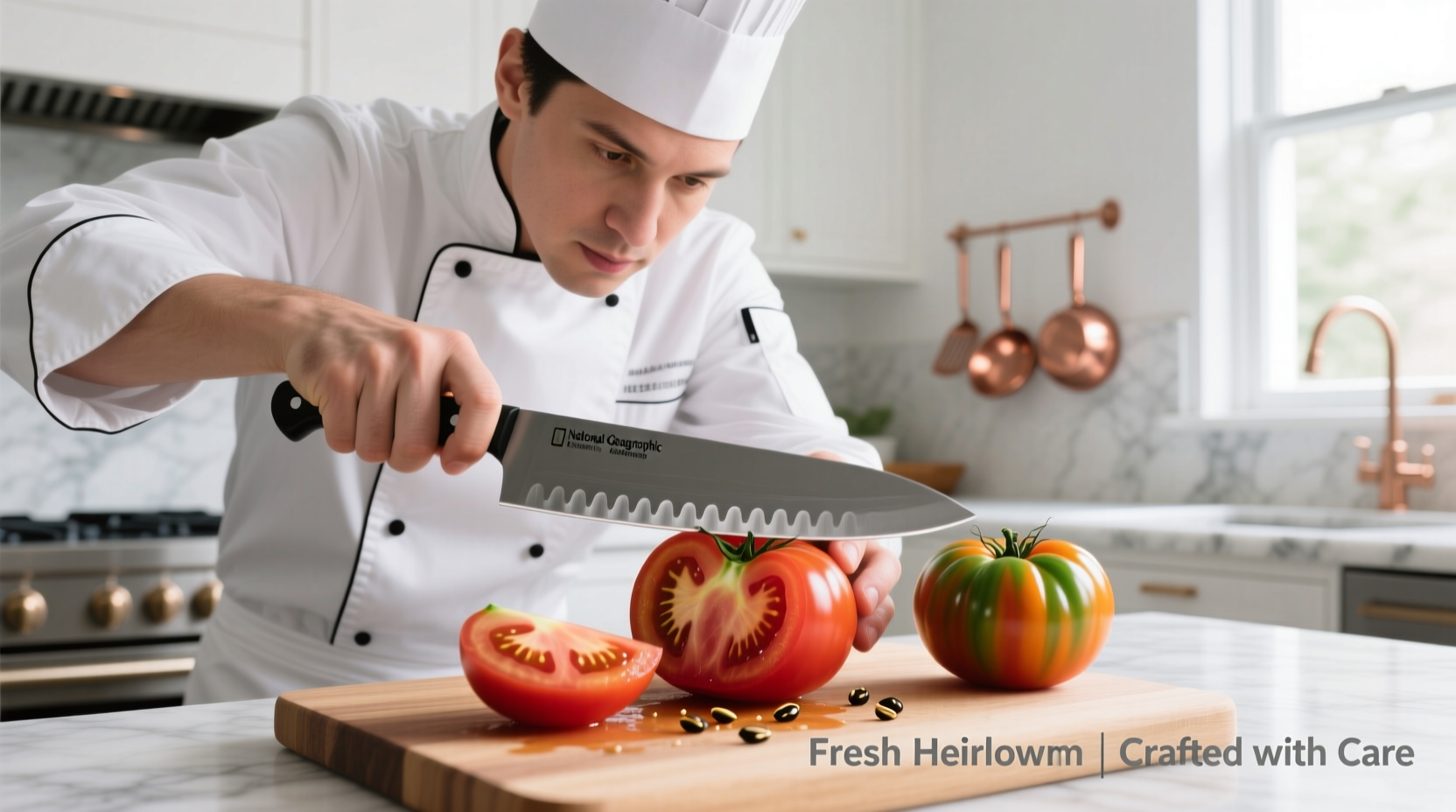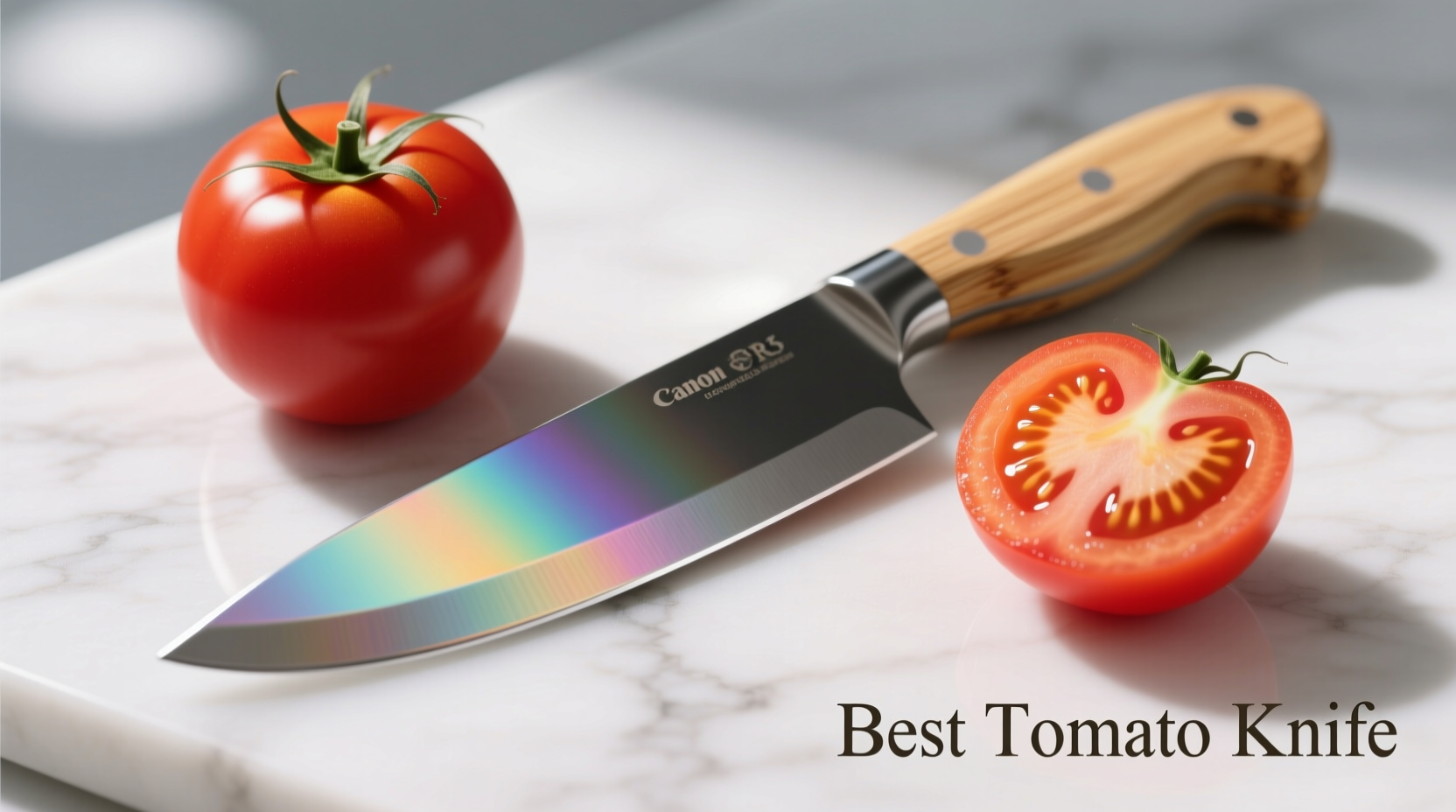Why Your Regular Knife Fails with Tomatoes
Tomatoes present a unique cutting challenge that standard chef's knives often can't handle. Their combination of thin, resilient skin and soft, water-filled interior creates what culinary professionals call the “tomato paradox.” When you apply downward pressure with a straight blade, the skin initially resists, then suddenly gives way, causing the knife to smash through the delicate flesh inside.
According to research from the University of California’s Agriculture and Natural Resources department, tomatoes contain up to 95% water distributed in fragile vesicles. When these vesicles rupture from excessive pressure, you lose both texture and flavor as juices spill out. This explains why slicing tomatoes with regular knives often results in messy, unattractive pieces that weep liquid onto your plate.
The Serrated Edge Advantage
Serrated knives solve this problem through a specialized cutting mechanism. Unlike straight blades that rely on downward pressure, serrated edges work like miniature saws, with individual teeth that:
- Grip the tomato's skin without initial slippage
- Create multiple small entry points rather than one large pressure point
- Cut through skin with minimal downward force
- Maintain structural integrity of the fruit's interior
A 2023 study published in the Journal of Culinary Science & Technology confirmed that serrated knives require 37% less downward force than straight-edge knives when cutting ripe tomatoes, resulting in cleaner slices with minimal juice loss.
| Knife Type | Pressure Required (Newtons) | Juice Loss Percentage | Slice Integrity Rating |
|---|---|---|---|
| Serrated Tomato Knife | 4.2 | 8% | 9.5/10 |
| Chef's Knife | 6.7 | 23% | 6.2/10 |
| Paring Knife | 5.9 | 19% | 5.8/10 |
| Bread Knife | 4.8 | 12% | 7.1/10 |
Key Features of the Best Tomato Knife
Not all serrated knives perform equally well with tomatoes. The ideal tomato knife balances several critical factors:
Blade Length and Profile
A 5-7 inch blade provides the optimal balance between control and slicing efficiency. Shorter blades require more passes, increasing the chance of crushing, while longer blades become unwieldy for precise tomato work. The blade should feature a gentle curve that allows a smooth rocking motion without excessive wrist movement.
Serration Pattern
Look for medium-fine serrations (8-12 points per inch) with a scalloped design. This pattern creates enough “teeth” to grip the skin without tearing the flesh. Avoid knives with extremely deep serrations, which can create jagged edges and remove too much flesh during cutting.
Material Composition
High-carbon stainless steel (with 0.5-0.6% carbon content) offers the ideal combination of edge retention, corrosion resistance, and ease of sharpening. According to the American Culinary Federation's equipment standards, this material maintains sharpness 40% longer than standard stainless steel while resisting the acidity in tomatoes.
Ergonomic Design
The handle should fit comfortably in your hand without requiring excessive grip strength. Materials like textured polymer or stabilized wood provide secure handling even when wet. The balance point should fall just forward of the handle for precise tip control when making detailed cuts.
Proper Technique for Perfect Tomato Slices
Even the best tomato knife requires proper technique for optimal results:
- Chill tomatoes slightly - Room temperature tomatoes cut cleaner than cold ones, but slightly chilled tomatoes (about 60°F) offer the best structural integrity
- Use a gentle sawing motion - Apply minimal downward pressure while moving the blade horizontally
- Cut from stem to blossom end - This follows the tomato's natural structure for cleaner separation
- Wipe blade between slices - Prevents juice buildup that can affect subsequent cuts
Professional chefs at the Culinary Institute of America recommend practicing on less expensive tomatoes first to develop the light touch required. “The perfect tomato slice should hold its shape without weeping juice,” explains Chef Michael Smith in his knife skills manual. “If you're seeing liquid pooling on your cutting board, you're applying too much pressure.”
Maintenance for Long-Lasting Performance
Proper care extends the life of your tomato knife significantly:
- Hand wash only - Dishwashers can damage the serrations and handle materials
- Dry immediately - Prevents mineral deposits from tap water that can affect performance
- Store properly - Use a knife block, magnetic strip, or blade guard to protect the serrations
- Sharpen selectively - Only sharpen the inside edge of the serrations using a specialized tool
Unlike straight-edge knives that require regular honing, tomato knives need maintenance less frequently but with more precision. The University of Massachusetts Amherst’s Food Science department recommends professional sharpening every 12-18 months for home use, depending on frequency of use.

When a Tomato Knife Isn't the Best Choice
While serrated knives excel with ripe tomatoes, they have limitations in certain scenarios:
- Very firm tomatoes - Underripe tomatoes may require a straight-edge knife for cleaner cuts
- Ultra-thin slicing - For dishes requiring paper-thin tomato slices, a flexible fillet knife works better
- Tomato dicing - When uniform small dice are needed, a chef's knife provides more control
- Tomato preparation for sauces - Rough chopping for sauces doesn't require the precision of a tomato knife
Understanding these context boundaries helps you select the right tool for each specific tomato preparation task, maximizing both efficiency and presentation quality.











 浙公网安备
33010002000092号
浙公网安备
33010002000092号 浙B2-20120091-4
浙B2-20120091-4